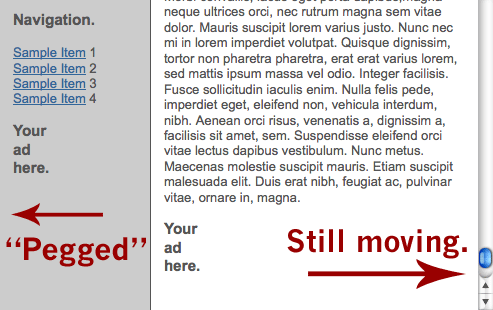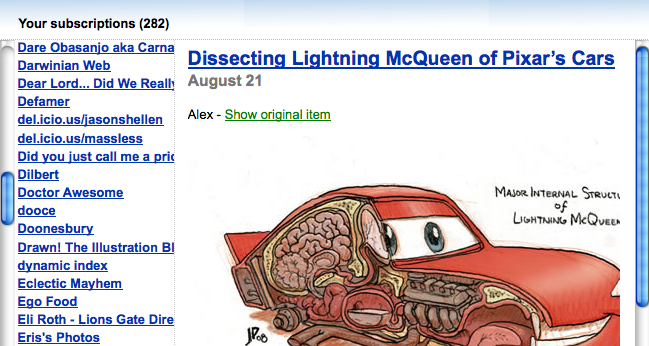Recently I was lucky enough to have Dustin Diaz spend his valuable time helping me update some promo photos. During the session I think I boasted that I could mimic the “Andy Stitzer” smile. He took me up on that.

(the original, for reference)

Pegs, an experiment in page layout and interaction.
Now that I'm thinking harder about page consumption again, I wanted to surface an old experiment from when I was working on Reader. I'm wondering if a better-executed version of this concept could be useful in an era where site navigation and ads are too easily scrolled off-page? (e.g. IMDB, especially)
It seems worth reconsidering ways to optimize content, nowadays.
Demo
The experiment looks like a normal page until the scrollbar is used. Content areas scroll only as high or low as their content.
Try out "pegs" by
visiting the demo and scrolling up and down.
ex. Screenshot of demo and concept. Two columns, left column doesn't scroll if small enough.

It's a little...odd. Can't tell if I like using it yet. Needs a trial with real content.
Caveats: It's an early work, still. Watch out for bugs.
How this began
Updated this story because I got it wrong. Crud. Better minds and archived emails now help show the important details I should have included.
All of us working on Google Reader were looking into ways of making navigation and selection state more visually appealing.
Mihai Parparita, tech lead of Reader's frontend, suggested we should have two scrolling areas for navigation and viewing but everyone wanted to figure out a better way than to have multiple scrollbars on a page.
It seemed sad that one scrollbar would interrupt selection state by being placed in the middle. I began work on a demo where the scroll bar would be hidden or at least minimized in some way. I wondered if it could work like the way a differential would work in a car. I began experimenting with just controlling both areas with the scrollwheel in one area only. (In my earlier post, I said I'd thought I'd written my "differential scrolling" notes and script after the left-hand-scrollbar experiment. Nope. That came
before, it turns out.)
Kevin Fox (who works now at FriendFeed, don'tcha know), also wanted a better way to scroll. While designing things for Reader, and based on other products he'd been working on (e.g. Calendar), he began considering controlling both areas with the scrollbar in one area only. Kevin and I
both came up with early implementations of scroll management.
(I should've remembered this - my apologies to Kevin - I'm adding it here so that people know that Reader's awesomeness and experimentation has had many sources.) My experiment used an internal scrolling element to control two areas via a fixed area and a header, Kevin's had a single scrollbar over the whole page with no header. Both were incredibly similar as each area scrolled independently of the other.
I'm pretty sure Kevin came up with the name "Pegs", though we're not sure. :)
Kevin's experiment
clearly influenced the development of mine. Right after seeing his, I broke out of thinking in terms of an interior set of elements whose scrolling was determined by a master source, and changed my demo to have the master source be at the document level. Much more interesting. Thank you, Kevin.
At the same
Nick Baum (among others) had an idea that any "pegged" approach could be smarter about how it managed the other bar, namely that some logic to when each column would scroll should be length-based. This was a huge improvement.
Days later, during a internal launch road map thread, it was Kevin who first mentioned that having the "Scroll bar on the left is a really interesting idea. <div dir="rtl"> :)" and since that sounded intriguing (and given I'd already finished my scroll-managing object that could do this, too) I made a demo of the left-hand-side insanity and sent it for feedback.
ex. Screenshot of the crazy left-hand version.

Whoops. Everyone agreed: It felt weird and alien to use. (Including Kevin and I.) I went back and modified my original demo with improved logic for scrolling. But we'd moved on... only later did I begin to improve the "Pegs" approach for general use.
posted at December 08, 2008, 6:23 PM
Santas! (A "shibboleth" service.)
Since I needed to crack my knuckles and have a warm-up, programming-wise,
I made a small service for creating a Secret Santa list.
I've been thinking of web services like these as "shibboleth" services. In my head these are applications where a password is required but
identity is de-emphasized, usually meaning users don't need to choose or manage a username or profile.
There's already a better name for this, right? Headless? Non-playered? Assisted authentication? I should know the term by now but I'm a little behind - nevertheless, it seems like they're easy and suitable for lightweight, fun usages.

posted at December 02, 2008, 5:28 PM
Possibly true trivia about U.S. Cabinet positions.
Jefferson, Monroe, and
Van Buren were all Secretaries of State who later became President.
source
Jefferson, Calhoun, and
Van Buren were all Secretaries of State who later became Vice-President.
source
No women have ever served as Secretaries of Treasury, Defense, Veterans Affairs, or Homeland Security.
source
Frances Perkins was described as an "angel at the Cabinet table" in an article in The Nation from 1933 after she became
the first woman in the U.S. Cabinet.
source
A President is said to have a "kitchen cabinet" when they have private advisors whose counsel they prefer over their actual Cabinet. (Reagan, Kennedy, and Jackson were accused of this.)
source
More woman have served as Secretaries of Labor then any other Cabinet position.
source
Elliot Richardson (famous for resigning rather than following Nixon's order to fire the person prosecuting the President for abuse of power) is the only individual to have served in four Cabinet-level positions: Secretary of Health Education and Welfare, Secretary of Defense, Attorney General, and Secretary of Commerce.
source
The remarkably named Salmon Portland Chase, who was Secretary of Treasury during the Civil War, introduced the first govt-issued-and-mandated paper currency for the U.S. and authorized the use of "In God We Trust" on its design. His name provided inspiration for The Chase National Bank, which is now part of the finance firm of JPMorgan Chase, though Salmon never had any formal connection with his eponymous institution. He later became Chief Justice of the Supreme Court and his face adorns the $10,000 bill.
source
Henry C. Wallace and Henry A. Wallace both served as Secretaries of Agriculture. Their names aren't similar coincidentally, they were actually a father and son Cabinet legacy ... and, in stranger notoriety, Henry A. was enraptured by a spiritualist who designed the set for the premiere of Stravinsky's "
The Rite of Spring" and whom Wallace sent letters claiming he awaited "the breaking of the New Day" when the people of "Northern Shambhalla" would create an era of peace and plenty. He then went on to become Vice-President under FDR. Later, he became editor of The New Republic. Then he created a new breed of chicken.
source
posted at November 22, 2008, 4:06 AM
Florida and Campaigning, Little Stories
The New Volunteer
Just after General Powell's endorsement of Obama for President, a bulldog of a man walks into the office, hands us his business card, and asks what volunteer work he can do for Barack. Casually he tosses out, "I'm a registered Republican and after the endorsement I felt it was time to come in here."
The Three Totals
One afternoon while out talking with voters, a field organizer for our office gets in a auto accident. Neither car involved can be driven anymore, and our organizer is hurt from the impact. An ambulance carries her to a local hospital, worry abounds, and her family is called. Shortly after being checked into the emergency room, our office gets a text message from her asking for status: "So, how many canvassers do I have out?"
Pitching and Catching
It's early evening in Tampa, and only an hour or so before the soon-to-be last game of the American League championship series. I'm suddenly conscripted from my office duties by a co-worker who shoves me in a car with a sign and some pamphlets and tells me I'm to stand in front of Tropicana Field and re-emphasize the start of early voting for Florida.
I'm ill-suited for this. We're at the entrance to the stadium and people are excited about the game, not politics. Despite being non-blocking in presentation (off to the side of the walkway) our voting signs show a picture of Obama, so our partisanship is evident and I'm uncomfortable with even a peripheral interruption.
I'm paired with Linda, in heels and short, she's about ten or fifteen years older than I am, throws a smile my way, pats me on my shoulder, then wades closer to the crowd of attendees.
"Vote early!" she says. "Voting for Obama? You can do so now."
She repeats this many times. Her voice doesn't carry too far, but passersby can see her sign. They glance at the image of Obama. And many of them (many!) turn their heads slightly and reply: "Fuck you."
She must've gotten over fifty "fuck you"s.
Later, we have to walk back to the office. It's many blocks, and there are no cabs or drivers available. She chucks off her heels and walks barefoot. And never stops. The whole way back she mentions to anyone passing, "Did you know you can vote early? And vote for Obama!"
Later, when she tells us she's another registered Republican volunteer, I whistle in appreciation.
Offerings
I've only had one day of canvassing, for the last few weeks, I've mainly worked with documents and computers and gadgets. In this new assignment, I prepare myself to meet with the common responses to a knock at the door: indifference, antagonism, frustration, annoyance.
I head out with a more experienced canvasser. On my first knock I'm nervous. A tall man answers...
He's proudly wearing an Obama baseball cap. And further inside, I can see his wife, who is wearing an Obama t-shirt.
They are very pleased we're at the door.
We're invited inside for cocktails, which I decline as I'm on duty, and because I begin to wonder if they'll be so many offerings that we'll have to weigh our options on their relative quality before choosing one.
I knock on many doors. Goodwill is in force. I'm later told my experience was "atypical." This just tells me that my co-workers are hiding all the good bounty.
Labels: politics
posted at October 22, 2008, 8:28 AM
I'm the newest member of Obama's Florida for Change office. (C'mon down.)
I was interested in doing more with my time than research and commentary for the US Presidential Election so in the beginning of October I'll become an in-state volunteer for the Florida for Change office for Barack Obama. Huge thanks to the Border State Director of Florida For Change for allowing me to be involved.
I'll be working primarily in Pinellas county. How swing is Pinellas? In 2004, the difference between Bush and Kerry was
less than 500 votes.
| Pinellas | 49.5% | 225,460 | 49.6% | 225,686 | 0.9% | 4,211 |
I'll be involved in anything the director and staff would like to assign to me as a responsibility. (Data, IT, and voter contact seems a likely group of tasks I'll be assigned, though.)
For those who'd also like to help in Florida, please sign up
at the Florida for Change signup on Obama's website. If you know me, please send me an email, SMS, direct twitter, facebook wall message, or catch me on the street and I'd be happy to direct you to the director for volunteering.
I keep wondering if I should list the reasons why I'm willing to put together a more-than-casual effort for a politician. I'd be happy to do so, but I've got a lot more preparation ahead of me and may not get the time.
Past performance isn't always a good indicator of future activity but interesting stats about Florida's voting record in the 2004 U.S. Presidential election are available via Wikipedia,
United States presidential election in Florida, 2004. For example, the color-coded county by county breakdown back then...

Labels: politics
posted at September 26, 2008, 6:06 PM
The Hidden Power: David Addington
David Addington is Chief of Staff for Vice President Cheney. Here's an excerpt from
a profile about him in the New Yorker from a couple of years ago.
 Most Americans, even those who follow politics closely, have probably never heard of Addington. But current and former Administration officials say that he has played a central role in shaping the Administration’s legal strategy for the war on terror. Known as the New Paradigm, this strategy rests on a reading of the Constitution that few legal scholars share—namely, that the President, as Commander-in-Chief, has the authority to disregard virtually all previously known legal boundaries, if national security demands it. Under this framework, statutes prohibiting torture, secret detention, and warrantless surveillance have been set aside.
Most Americans, even those who follow politics closely, have probably never heard of Addington. But current and former Administration officials say that he has played a central role in shaping the Administration’s legal strategy for the war on terror. Known as the New Paradigm, this strategy rests on a reading of the Constitution that few legal scholars share—namely, that the President, as Commander-in-Chief, has the authority to disregard virtually all previously known legal boundaries, if national security demands it. Under this framework, statutes prohibiting torture, secret detention, and warrantless surveillance have been set aside.
Emphasis mine. According to many sources, he's been the author (or most senior legal support) of many of the most controversial legal policies of the Bush Administration. He was described by U.S. News and World Report as "the most powerful man you've never heard of".
He's the lawyer behind over 750 signing statements that President Bush has added to bills passed by Congress. He seems to have a different understanding of the Constitutional separation of powers, namely, that no one has the right to examine how executive decisions are made and that in times of war (which is always now since the War on Terror doesn't take a break) the President cannot be restrained by Congress nor any law, national or international.
Some results of this interpretation range from the benign and reasonable to the possibly criminal and include Bush and his team refusing requests for information (as in
the case of Pat Tillman's death), documents (an
F.B.I. and mob scandal), and clarification (the
details of Cheney's energy task force), and has included their directly refusing to obey subpeonas in the investigation of the firing of federal prosecutors. In the last example, the executive branch has successfully avoided legal inquiry with the only consequence being
two aides held in contempt by the House of Representatives but whose charges won't be pursued by the Justice Department because of executive privilege.
"Our political heritage is to be skeptical of executive power, because, in particular, there was skepticism of King George III." So says Jane Mayer, the author of the New Yorker article. But I can only guess we're no longer inheritors of that concern given the very real reduction of Presidential oversight over the last eight years.
Which leads me to admit - I feel like I can't be an informed voter without knowing what self-imposed limits an Obama or McCain or Biden or Palin presidency would place on their unrestrained and secret power. But even if they promised to restrain themselves...how would we ever know if they had?
Labels: politics
posted at September 18, 2008, 3:05 AM
Previously on massless.org ›
Previously on massless.org




















Most Americans, even those who follow politics closely, have probably never heard of Addington. But current and former Administration officials say that he has played a central role in shaping the Administration’s legal strategy for the war on terror. Known as the New Paradigm, this strategy rests on a reading of the Constitution that few legal scholars share—namely, that the President, as Commander-in-Chief, has the authority to disregard virtually all previously known legal boundaries, if national security demands it. Under this framework, statutes prohibiting torture, secret detention, and warrantless surveillance have been set aside.

